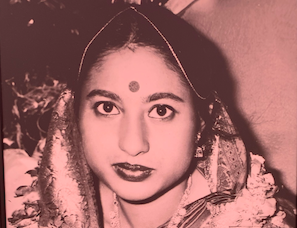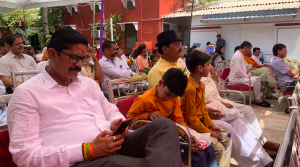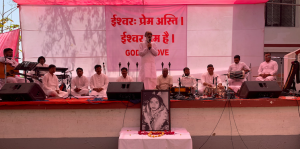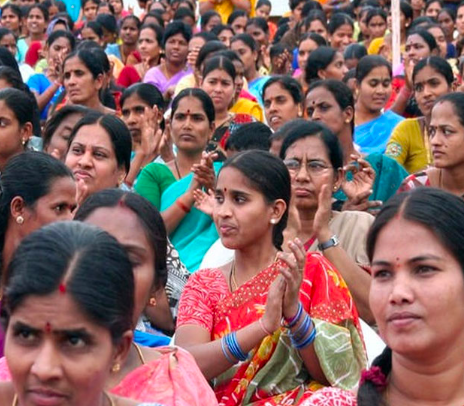
by Ron Hjertstedt | Apr 9, 2022 | Current News Topics, News Flash!, School News
On Thursday, 7 April 2022, we paid tribute to our founder, our friend and teacher, our mother, Rebecca Shourie. Many people came from across India and from overseas. Rebecca surely touched the hearts and lives of many people in her time on this earth. She lived with passion and grace and yet held on to this life lightly, holding on to only God’s love with a tight grip.
Thank you to all our family, friends, students, and Nagod citizenry for attending our tribute to Bade Ma’am both in person and virtually and remotely (via the internet).
May we all live for God’s love and peace with each other, to create a solid community, a great town and country, full of citizens of integrity and love, peace and kindness.
Love and serve one another.




by Ron Hjertstedt | Feb 10, 2022 | News Flash!, Student Corner
Shopping has always been an activity in which customers browse the shelves for available goods or services at various physical retail outlets — actual shops. Since the beginning of known history, humans have directly exchanged goods and services with one another in a system of trading (barter — this service or product for that service or product). As civilizations grew, the system of barter was replaced with retail trade involving coinage. Money. That is the system in which we have been familiar for the last few centuries — the system of our parents and grandparents, including most of our lives.
However, customers now can simply access the “marketplace” via the internet by using their computers or smartphones. No need for our physical presence, physical products to be seen and touched, or travel outside the home. This new form of market is the emerging mode of business known as e‑business. It has been active in “developed” countries for decades, but it is now operating in full force in India, and there are definitely serious effects on our way of life and the landscape of physical shops that families have spent decades investing themselves in.
In the present-day context, learning and analyzing consumer behavior is extremely vital for the success of a business. The fundamental issue which arises in front of a consumer when he/she embarks on a shopping endeavor is now, which mode of shopping should they choose to satisfy their own needs. Should they purchase online or offline? Go to a traditional marketplace or a virtual one? Who will they reward with their purchase: The actual shop-owner in their town, or an unseen, virtual one that they don’t know?
The question facing us is whether or not online shopping is better than offline. Who should we reward with our purchase? What kind of ripple effects happen to our physical town and local stores when we make our purchased online from far-off vendors? How are we hurting our local economy, and therefore ourselves?
The online shopping industry has flared up to a point where people prefer to shop online due to ease of purchase, convenience, variety of products, and tech savvy consumers able to effectively surf the net for exactly what they want. People can shop 24/7 from wherever they want, and the world is at their fingertips. There is no hustle and bustle, no rushing, no crowded shops.
But, the fact is that our online habits of purchasing goods is affecting our local business-owners, our towns, our way of living. Or is it?
The traditional way of offline is still considered best by many. People want to physically check the products and have face-to-face communication (bargaining, etc.). It is also relatively easier to return products in person than online. If we have product complications after an online shopping experience, we face more problems when trying to negotiate or return the product. There are also higher chances of shipping issues, packaging problems, mishandling by the delivery company, and risk of fraud if we enter the wrong website marketplace.
The internet was opened to the public in 1991, and soon afterwards online shopping became possible. Since that time, the online shopping experience has become much smoother and enjoyable for the consumer. People have become less skeptical of online shopping over the years.
In conclusion, it is the opinion of our student editorial group that BOTH traditional and online shopping are important to us. Despite the rapid growth of online sales in India, and the projected exponential growth of that industry, the majority of consumers in India still prefer traditional shopping — especially since a huge portion of Indians don’t hav access to online shopping methods, nor the wherewithal to understand how to navigate the internet shopping experience. People want to see the shop-owner and touch and try on the product in real time.
Both online and offline experiences have their good and bad points, problems and benefits. There is a trust issue for us when dealing with money online. However, the allure of a better product assortment and easy shopping experience is a benefit for the online proponents. There are serious responsibilities we have of taking care of our towns and local shopping centers by continuing to shop offline so that we reward our local vendors and their families — making our towns strong. Also, questions of what is better for the environment — offline or online?
In any event, how we spend our money is extremely important. Every rupee we spend is a reward to someone for something. We need to take many issues into account when we buy something either online or offline. Time marches on, and we have to adjust to modernity and yet remain true to our values.

by Ron Hjertstedt | Jan 13, 2022 | News Flash!, Student Corner
Finally, More Females than Males in India
A recent census shows that there are remarkably more females than males in India for the first time in over one thousand years!
One of the most important structural aspects of a society is the relative number of males and females who compose it. According to the Fisher’s Principle, gender ratio is defined as the proportion of females relative to one thousand males in a population. In India, we are now seeing, for the first time since the onset of modern record-keeping, the gender ratio as tipped in favor of females. Now, for the first time since the Vedic Period, over 1,000 years ago, for every 1,000 males, there are 1,020 females according to the National Family Health Survey‑5.
During the Vedic Period in India (1,500 BCE — 50 BCE), women enjoyed absolute economic and societal status, and equality and freedom (although it wasn’t perfect as a boy-child was still preferred over a girl-child). The Vedic Period is known as the “Golden Age” for women in India. That era was characterized by the absence of the purdah system (the practice of keeping men and women separate), no discrimination for educational opportunities between the genders, equal rights in selection of partners, polygamy being rare, and widows being able to marry again.
In the post-Vedic period, the status of women fell: women suffered many setbacks when various restrictions were put on women’s rights and privileges. It became increasingly untenable to birth a girl-child instead of a boy-child. Education, which had been an accepted norm for women, was neglected, and later on, girls were totally denied access to education. The Medieval Period was the darkest era in the history of India for women. The status of women in society further deteriorated when child marriage, a ban on re-marriage for widows, the purdah system, polygamy, Jauhar, and sati Pratha (throwing women onto her her husband’s funeral pyre) became a regular part of cultural life.
A gender ratio which is not in favor of women is a dangerous sign for any society because it indicates a high female fetal mortality rate, selective abortions, and excess female deaths. India is a patriarchal society where there is active gender selection by parents, which means that many girls are killed before they are even born. Parents expect sons, not daughters, to provide financial and emotional care, especially in their old age: Sons add to family wealth and property while daughters drain it through dowries; sons continue the family lineage while daughters are married away to another household. People often have a belief that a girl is a liability while a boy is an asset. Misuse of advanced parental diagnostic techniques (sonograms) has led to gender selection with the widespread termination of female fetuses which contributes to a rapidly declining girl-to-boy ratio.
In recent years, India has enacted several government initiatives (see addendum below) to address these important issues in order to begin the process of creating a more optimistic future for females in India from birth throughout all of life by protecting them more holistically and fully.
The status of women improved during the wave of feminism in India in the last few decades. The Feminist Movement (also known as the Women’s Liberation Movement) refers to a series of political campaigns that aim to define and establish the political, economic, personal, and social equality between the sexes. The focus was on institutional reforms which resulted in reduced gender discrimination, giving women access to male-dominated spaces, and promoting equality. However, despite all of that, evils such as domestic violence, female infanticide, sexual abuse, and abortions for gender selection still exist in our society and must be addressed openly with meaningful reforms taking place.
Despite the continued issues of gender inequality, good news is indeed good news, and we should discuss it and celebrate it. The ratio of females to males in India has indeed equalized for the first time in over a thousand years. Our country is finally beginning to appreciate the deep value that females bring to the table to make India a world leader. The importance of protecting the equal rights, safety, and health and welfare for females of all ages is a foundational aspect upon which we can build a modern culture and be a world leader.
This turn of events is largely due to the increasing life-expectancy of females as well as the changes that have been made in the public consciousness as well as the various government initiatives. Although safe spaces for open conversations are happening on an increasing basis, we still need to make constant assurances that we will acknowledge the dignity of women. Laws that protect women are on the books, but they need to be enforced, and perhaps we need even more laws to ensure that the life of all females is protected and safe from inequality, discrimination, child marriage, abortion, violence, rape, beatings, verbal abuse, mutilation, torture, “honor” killings, and trafficking.
Gender equality must be discussed, encouraged openly, and protected in our country in order for us to become the world leader that India is capable of.
Thus, it is imperative to put even more focus on improving the existing policies, laws, and programs to ensure the survival and utter respect for all females in Indian society. We must continue to protect females from harm and disrespect. We must build upon these ideas and not slide backwards once again.
“Yatıra nariyasthu pulyathe remanthe ththra devethha”: The meaning of this Sanskrit sloka is “Where women are respected, there angels will reside”.
* Government Initiatives
- Beti Bachao Beti Padhao (BBBP) aims to generate awareness and ensure protection, survival, and education for the girl-child.
- Working Women Hostel (WWH) promotes the availability of reliable accommodation and ensures the safety and security for women.
- Balika Samridhi Yojana (BSY) focuses on helping girls and motivating them to take up income-generating activities for their own welfare.
- Sukanya Samridhi Yojana focuses on securing a dazzling future for the females.
- Women’s Helpline Scheme focuses on providing 24-hour emergency response to women affected by violence.
Thank you for reading our blog!
The Satya Niketan Higher Secondary School Student Leadership Website Editorial Team




